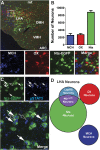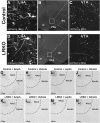Loss of Action via Neurotensin-Leptin Receptor Neurons Disrupts Leptin and Ghrelin-Mediated Control of Energy Balance
- PMID: 28323938
- PMCID: PMC5460836
- DOI: 10.1210/en.2017-00122
Loss of Action via Neurotensin-Leptin Receptor Neurons Disrupts Leptin and Ghrelin-Mediated Control of Energy Balance
Abstract
The hormones ghrelin and leptin act via the lateral hypothalamic area (LHA) to modify energy balance, but the underlying neural mechanisms remain unclear. We investigated how leptin and ghrelin engage LHA neurons to modify energy balance behaviors and whether there is any crosstalk between leptin and ghrelin-responsive circuits. We demonstrate that ghrelin activates LHA neurons expressing hypocretin/orexin (OX) to increase food intake. Leptin mediates anorectic actions via separate neurons expressing the long form of the leptin receptor (LepRb), many of which coexpress the neuropeptide neurotensin (Nts); we refer to these as NtsLepRb neurons. Because NtsLepRb neurons inhibit OX neurons, we hypothesized that disruption of the NtsLepRb neuronal circuit would impair both NtsLepRb and OX neurons from responding to their respective hormonal cues, thus compromising adaptive energy balance. Indeed, mice with developmental deletion of LepRb specifically from NtsLepRb neurons exhibit blunted adaptive responses to leptin and ghrelin that discoordinate the mesolimbic dopamine system and ingestive and locomotor behaviors, leading to weight gain. Collectively, these data reveal a crucial role for LepRb in the proper formation of LHA circuits, and that NtsLepRb neurons are important neuronal hubs within the LHA for hormone-mediated control of ingestive and locomotor behaviors.
Copyright © 2017 Endocrine Society.
Figures








Similar articles
-
Leptin action via neurotensin neurons controls orexin, the mesolimbic dopamine system and energy balance.Cell Metab. 2011 Sep 7;14(3):313-23. doi: 10.1016/j.cmet.2011.06.016. Cell Metab. 2011. PMID: 21907138 Free PMC article.
-
Leptin acts via lateral hypothalamic area neurotensin neurons to inhibit orexin neurons by multiple GABA-independent mechanisms.J Neurosci. 2014 Aug 20;34(34):11405-15. doi: 10.1523/JNEUROSCI.5167-13.2014. J Neurosci. 2014. PMID: 25143620 Free PMC article.
-
Lateral Hypothalamic Area Neurotensin Neurons Are Required for Control of Orexin Neurons and Energy Balance.Endocrinology. 2018 Sep 1;159(9):3158-3176. doi: 10.1210/en.2018-00311. Endocrinology. 2018. PMID: 30010830 Free PMC article.
-
Lateral thinking about leptin: a review of leptin action via the lateral hypothalamus.Physiol Behav. 2011 Sep 26;104(4):572-81. doi: 10.1016/j.physbeh.2011.04.060. Epub 2011 May 3. Physiol Behav. 2011. PMID: 21550356 Free PMC article. Review.
-
To ingest or rest? Specialized roles of lateral hypothalamic area neurons in coordinating energy balance.Front Syst Neurosci. 2015 Feb 18;9:9. doi: 10.3389/fnsys.2015.00009. eCollection 2015. Front Syst Neurosci. 2015. PMID: 25741247 Free PMC article. Review.
Cited by
-
The Role of Central Neurotensin in Regulating Feeding and Body Weight.Endocrinology. 2021 May 1;162(5):bqab038. doi: 10.1210/endocr/bqab038. Endocrinology. 2021. PMID: 33599716 Free PMC article. Review.
-
Effect of Monoclonal Antibody Blockade of Long Fragment Neurotensin on Weight Loss, Behavior, and Metabolic Traits After High-Fat Diet Induced Obesity.Front Endocrinol (Lausanne). 2021 Oct 8;12:739287. doi: 10.3389/fendo.2021.739287. eCollection 2021. Front Endocrinol (Lausanne). 2021. PMID: 34690932 Free PMC article.
-
Obesity-related gut hormones and cancer: novel insight into the pathophysiology.Int J Obes (Lond). 2021 Sep;45(9):1886-1898. doi: 10.1038/s41366-021-00865-8. Epub 2021 Jun 4. Int J Obes (Lond). 2021. PMID: 34088971
-
Complementary lateral hypothalamic populations resist hunger pressure to balance nutritional and social needs.Cell Metab. 2023 Mar 7;35(3):456-471.e6. doi: 10.1016/j.cmet.2023.02.008. Epub 2023 Feb 23. Cell Metab. 2023. PMID: 36827985 Free PMC article.
-
Individuals with type 2 diabetes have higher density of small intestinal neurotensin-expressing cells.Mol Cell Biochem. 2023 Dec;478(12):2779-2787. doi: 10.1007/s11010-023-04698-z. Epub 2023 Mar 15. Mol Cell Biochem. 2023. PMID: 36920577 Free PMC article.
References
-
- Anand BK, Brobeck JR Localization of a “feeding center” in the hypothalamus of the rat. Proc Soc Exp Biol Medi 1951;77(2):323–324. - PubMed
-
- Morrison SD, Barrnett RJ, Mayer J. Localization of lesions in the lateral hypothalamus of rats with induced adipsia and aphagia. Am J Physiol. 1958;193(1):230–234. - PubMed
Publication types
MeSH terms
Substances
Grants and funding
LinkOut - more resources
Full Text Sources
Other Literature Sources
Molecular Biology Databases

